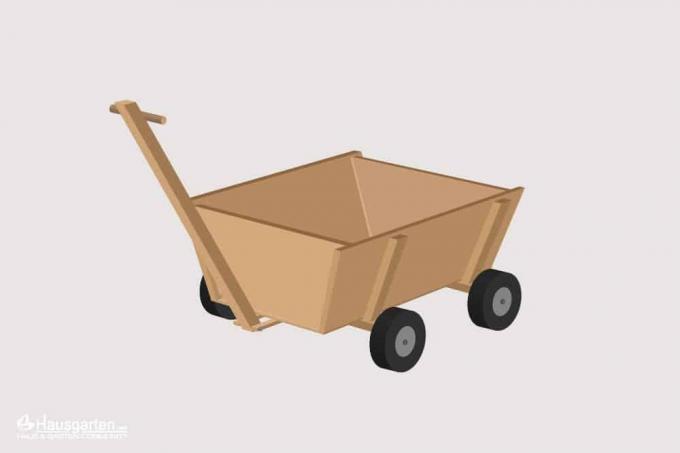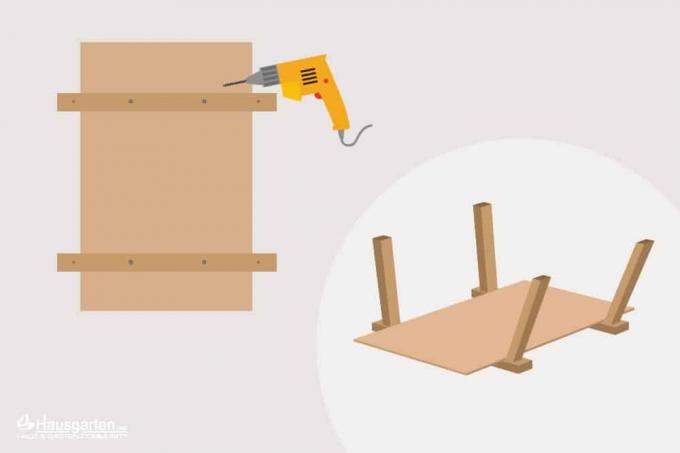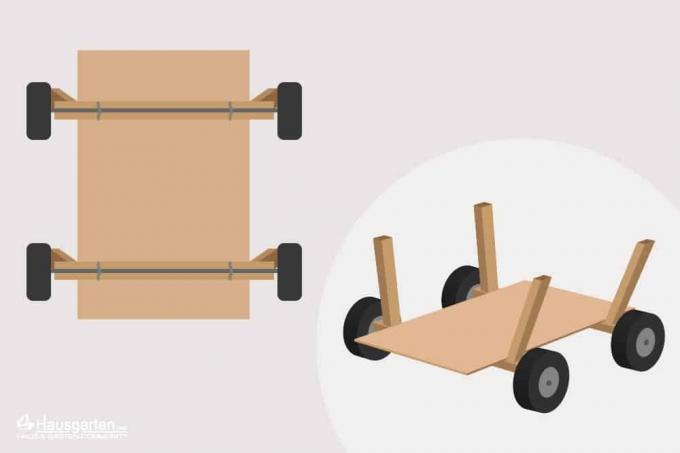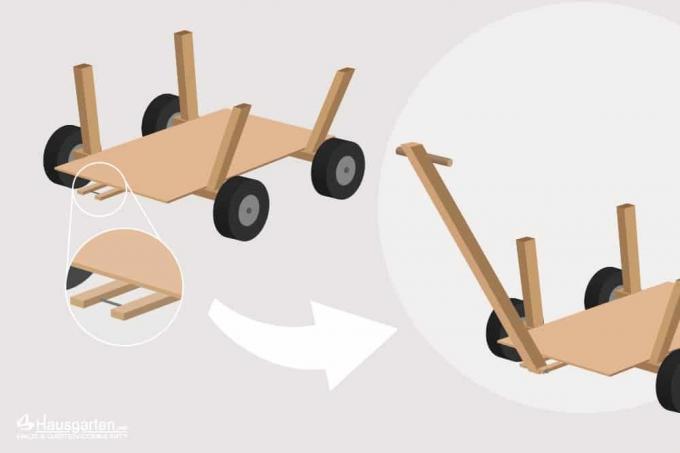

Table of contents
- You need that
- Costs
- Building instructions handcart
- Cut wood - smooth edges
- Pre-drill and countersink holes
- Screw the crossbars and side struts together
- Mount wheels and axles under the floor
- Build drawbar and handle
- Screw strips onto side panels
- Paint handcart
- Tips for speed readers
Your own handcart will soon be used more often than you initially thought. Many do-it-yourselfers build the handcart themselves because they think it will only be used infrequently. After a few excursions, the practical piece also finds its job in your own garden at work. Owners of a wood-burning stove will appreciate the small transport wagon even more, because it transports a lot of wood from the shed to the house and also brings the briquettes. In order for the handcart to remain so versatile, it should be simple and flexible.
You need that
- drilling machine
- cordless screwdriver
- Forstner bit / countersink
- wood drill
- saw
- sandpaper
- Ring / open-end wrench
- screwdriver
- Paint brush
- Base plate birch plywood / multiplex panels 60 x 40 cm / 5 mm thick
- Side panels 2 x birch plywood / multiplex panels - 60 x 30 cm / 3 mm thick
- Front panels 2 x birch plywood / multiplex panels - 40 x 40 cm / 3 mm thick
- Bar about 2 x 2 cm thick
- Slat about 3.5 x 3.5 cm thick
- Broomstick / strong rope / bar for handle bar
- spax screws
- 4 wheels
- 2 axles / threaded rods
- U clamps
- washers and nuts
- sleeves / spacer sleeves
- acrylic paint
Costs
First of all, many do-it-yourselfers naturally ask themselves why they should build their own handcart when there are so many models on the market. The second question is, of course, which is financially cheaper, building it yourself according to our assembly instructions or buying a handcart made of wood or metal. One of the answers lies in the personal bond with the handcart. Your children are guaranteed to pass on the good piece that you have built for them to their own children and grandchildren. You will certainly not build up this relationship and, above all, great pride with a purchased hand truck. Nevertheless, a self-made wagon is in most cases much cheaper than a purchased wagon.
So that you can estimate the costs involved quite accurately, we show different prices for the important materials in different versions here:
- Set of 4 wheels - hand truck wheels with air tires - about 20.00 euros
- simple rubber wheels without an air hose - 4 pieces from about 12.00 euros
- Axle 2 pieces - threaded rod with shaft - from about 15.00 euros
- Complete set of axles and wheels – from EUR 38.00
- Birch plywood - multiplex panels - 60 x 40 centimeters - 5 mm thick - about 3.80 euros
- Birch plywood - multiplex panels - 60 x 30 centimeters - 3 mm thick - about 2.70 euros
- Spax screws - 100 pieces 3.5 x 40 mm - about 4.00 euros
- Drawbar – homemade with a broom handle and wooden bracket – around 2.00 euros
- Drawbar bought ready - from about 20.00 euros
Tip:
With pneumatic tires you have significantly better suspension in your handcart. However, you then have to inflate the tires before almost every use. Unfortunately, pneumatic tires always lose pressure over time, especially if the vehicle has been in the shed for a while. However, with unsprung hard tires, you'll shake your Father's Day beer so violently that it will either blow up on its own or foam over when you open it. Even children who sit part of the way in the handcart will not survive the journey without bruises if you choose the hard tire variant.
Building instructions handcart
Since the handcart only gradually shows its true qualities, you should not have any too narrow ideas for building your own when planning the construction. A wagon that fits a specific type of beer crate isn't going to be nearly as practical as a slightly more generous model that's more of a universal blueprint. Therefore, your first step should be to adapt the building plan from our building instructions exactly to your dimensions if you don't want to copy it exactly. Don't make your model too small, however, so that the wagon remains practical.
Tip:
A simple old crate is usually sufficient for a simple handcart, which may actually only be used to haul the firewood through the garden. For example, a large crate of apples or potatoes is well suited for such a trolley. The same robust pneumatic tires can also be installed underneath. A simple smaller fruit crate is also good if you want to build a small pushcart for a child to play with. So the work will not be a complete self-construction, but with a little color this model can also be designed very individually.
Cut wood - smooth edges

Depending on the size, you may not have to saw the side parts and the bottom at all, since the right panels are often available in different sizes in every hardware store. Otherwise, much of the wood will also be cut to fit you there. You should still round off the edges with sandpaper. The front and the rear panel must be chamfered so that they later fit exactly between the strips on the side panels. You should also saw the slats that run across under the handcart. These must protrude far enough on the sides that the side struts can be screwed onto them. The upright side braces must be sawn off at an angle of about 30 degrees at the bottom. This will hold the side plates at the correct angle later.
Tip:
If you're a beginner and still unsure, it's best to wait until you've attached the upright braces holding the side panels before sawing the front and rear panels.
Pre-drill and countersink holes

Try to pre-drill all the holes and countersink them as lightly as possible. Use a very thin wood drill to pre-drill. The wood drill should be no more than three millimeters thick. This is not always easy with the thin plates, so you have to work carefully with the Forstner bit. The side braces should be pre-drilled from the beveled underside. The hole should be centered in it. The cross braces must also be pre-drilled so that the long screws can be fed through there.
Screw the crossbars and side struts together

The correct length of the screws depends on the thickness of the battens and the birch plywood. For each of the four side struts you need a long, thin spax screw. The crossbars are screwed under the floor. Then place the side struts on the crossbars and screw them from below.
Tip:
Instead of the wooden side braces, you can also use short pieces of pipe. However, you then have to secure them with cotter pins in the cross braces. In this case, the side parts would either only be leaned against or screwed together with small pipe clamps in a U-shape.
Mount wheels and axles under the floor

The simplest way to mount the axles is to use U-shaped pipe clamps. In some building instructions, a fastening made of multiplex is described. But over long distances, the wood will knock out quickly and the handcart no longer runs smoothly. The U-clamps are attached to the crossbars. A threaded rod with spacers, sleeves and washers is then pushed under the carriage. Make sure that there is a sleeve under each U-clamp so that the axle does not rub against the wood. The wheel with the corresponding sleeves is placed on the outside of the axle and secured with washers and a cap nut.
Tip:
Of course you can also use real axle bearings and axle shafts. Especially if you really often travel long distances, the investment can actually be worthwhile. This is not always absolutely necessary for occasional use.
Build drawbar and handle

A small, thin slat or a broomstick is ideal as a handle for the wagon. Screw the middle part of a wooden hanger to it at the upper end. This way, the handle will later sit comfortably in your hand, even over long distances. Two small pieces of the slat are screwed to the front of the base plate. These should be mounted approximately the width of the handlebar apart. The handlebar is then secured between these slats with a small threaded rod. Don't forget the washers here, too, so that the wood doesn't scrape the wooden pole. Cap nuts should also be placed on the outside here. Grease the rod well.
Tip:
If the handcart should be easy to stow away, the long handle bar can usually be a bit annoying. Instead of the pole, you can also simply attach a thick rope to the handcart. This may not be entirely stylish, but it is still very comfortable and easy.
Screw strips onto side panels

Two narrow strips are screwed vertically onto the side parts from the inside at the back and front. The distance between the battens should be slightly more than the thickness of the front and rear panels. These are later inserted between these strips. Then the side parts are screwed to the upright struts.
Tip:
If you prefer to work with glue, you can simply glue the strips on. After all, the strips should only hold the two end plates. If you want to install a small bench for the children in the handcart, you will also need a bar across each side wall. However, it cannot be glued, otherwise the children would collapse with it. A seat board is placed over these strips, which you can easily remove if necessary.
Paint handcart
It is not absolutely necessary to paint the handcart, but the wood stays beautiful for longer. After all, the weather isn't always nice when you're out and about. Dirt also likes to splash against the unprotected wood. If you want to preserve the wood grain you should use an acrylic based clear coat. However, a handcart in particular can also be painted brightly and colorfully.
Tips for speed readers
- Adapt the construction plan to your own wishes
- Cut wood and sand down edges
- Pre-drill and countersink holes
- Screw crossbars and side braces to the floor
- Attach U-shape pipe clamps to crossbars
- Mount wheels and axles on the floor
- Build drawbar from slats and screw under
- Build a pull rod from a slat and a wooden bracket
- Screw strips onto side panels
- Screw the side panels to the upright struts
- Slide the front and end plates between the strips
- Screw strips for child seat to side parts
- Lay the seat board on the slats
- possibly paint handcart
 Home editorial office
Home editorial office
Learn more about crafting

Crafts with willow branches | Make your own willow decorations
The fresh branches of willow are amazingly flexible and can be processed in many ways. In addition, willow branches are still durable and are used for various purposes in the natural garden. However, before crafting with already dry willow rods, soaking is required.

Make signs for the herb garden yourself: Make herb signs
You can get signs for the most common herbs in stores, but home-made herb signs have much more charm and can be labeled individually. Thanks to meaningful labeling, mix-ups in your herb garden are now a thing of the past.

Building instructions: Make your own sundial – that’s how it works!
Sundials were the most important timekeepers before the invention of mechanical clocks. Even the Egyptians and Romans used the time measurement based on the position of the sun in the sky to divide the day into reliable, smaller time units. So what could be nicer than setting up a sundial in the garden yourself - and not just as a decorative object, but a really functional sundial?

Make and fill lavender bags yourself - instructions for sewing
You can hardly avoid lavender in everyday life: tea, perfume, room sprays and even chocolate are refined with the aromatic herb. If you grow your own lavender in the garden, you can make beautiful scented sachets from it in no time at all. A great gift idea.

send plants | 7 tips for sending flowers
Sending plants requires good preparation. Not only the type of packaging is of great importance, so that the goods arrive safely at their destination. The season is also important. It depends on how well the plants survive the transport.

Fight houseflies: 10 remedies & tips
The housefly can be fought with various traps that have been prepared with attractants. Adhesive surfaces or liquids ensure that the insects can no longer escape. In addition, there are simple measures to keep the annoying flies out of the apartment.
